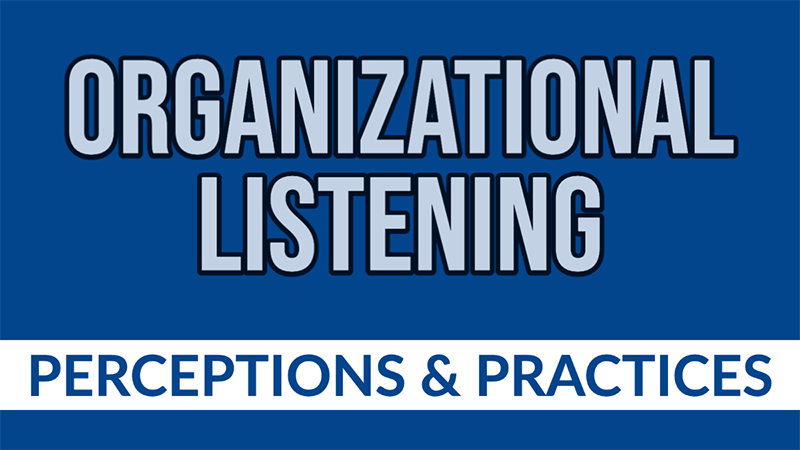Why is organizational listening easier said than done?
April 15, 2022

By Lisa Tam, Queensland University of Technology; Soojin Kim, University of Technology Sydney; and Helen Hutchings, Phillips Group
Macnamara wrote: “organizational listening is easier said than done because of the challenges of scale and diversity of views among stakeholders and publics." It is ideal to capture as many perspectives as possible from diverse groups of stakeholders and publics. But in reality, there are enabling and constraining factors that affect perceptions and practices of organizational listening. To examine these factors, we collected three datasets from December 2020 to March 2021.
First, we conducted a survey to explore the effects of stakeholders’ pre-existing perceptions of an organization. To ensure all respondents had a relationship with the organization tested in the survey questions, we used the Australian government and high-rise development as the example. We made the following findings from a nationally representative sample (by age and gender) of 400 Australian citizens:
- Respondents who think that the Australian government listens to diverse citizens tend to (a) trust the government more, (b) feel that it involves them in the government’s decision making, (c) be more receptive to information provided by the government and (d) be more willing to share their opinions with the government.
- Respondents who think that the Australian government only listens to a selected group of people tend to (a) trust the government less, (b) think that it only cares about its own image, (c) feel that their voices are not being heard, and (d) attribute responsibility to the government for the issue of high-rise overdevelopment in Australia.
- When the Australian government’s communication strategy is perceived to be “image-centric” (e.g., advocating for its own position rather than reflecting the needs of its citizens), it (a) reduces trust, (b) causes people to think it only listens to a selected group of people, and (c) leads to belief in conspiracy theories about the government.
- When the Australian government’s communication strategy is perceived to be “relationship-centric” (e.g., seeking to understand the changing expectations of its citizens), it (a) increases trust, (b) causes people to think it listens to diverse citizens, and (c) reduces the tendency to believe in conspiracy theories about the government.
Second, we conducted a 3x4 experiment to explore the effects of the choice of listening channels and decision-making mechanisms. The following findings were made from a nationally representative sample (by age and gender) of 426 Australian citizens:
- Of the three channels tested (i.e., community forum, online form, and Facebook), community forum is perceived to be the most effective in capturing diverse stakeholders’ feedback and increasing trust in an organization while Facebook is the least effective channel.
- Of the four decision-making mechanisms tested (i.e., consensus, majority view, strategic alignment and holding further consultation), strategic alignment is considered to be the least fair and appears to decrease trust in an organization. Strategic alignment is defined as making a decision based on feedback which is aligned with the organization’s strategy.
- However, people’s views about a preferred solution affect how they evaluate an organization’s decision-making mechanism. In other words, if the solution proposed by an organization is not one that they prefer, they will evaluate the decision-making mechanism negatively.
Lastly, we conducted interviews with 28 Australian public relations practitioners to understand their roles in organizational listening. The following findings were made:
- Organizational listening is generally understood as facilitating shared understanding between organizations and stakeholders. But its purpose could be organization-centric (e.g., informing the organization’s communication strategy) or public-centric (e.g., adjusting organizational actions to the needs of publics).
- Practitioners play multifaceted roles in listening as a continuous process. They design the process, execute the process including verifying feedback from multiple sources and synthesize the feedback before presenting it to management.
- Practitioners ensure diversity by using criteria such as age, gender, geographic location, viewpoints, and access to technology and by using multiple channels. However, because not all feedback can be implemented, practitioners must be careful in setting expectations and commitments and negotiating outcomes with stakeholders.
The findings of our study show that stakeholders’ evaluations of organizations’ listening practices can be affected by their:
- Pre-existing perceptions about the organization doing the listening
- Evaluations of the organization’s communication strategy
- Evaluations of the listening channels used
- Evaluations of the decision-making mechanisms
Our findings also show that the listening process and outcomes could be affected by practitioners’:
- Acknowledgement of what can and cannot be implemented (based on an organization’s decision-making criteria)
- Segmentation of publics by influence
- Synthesis of different views for presentation to management
We presented some of our research findings in a QUT Business Breakfast webinar on March 31, 2022. Click here to watch a recording of our presentation.

